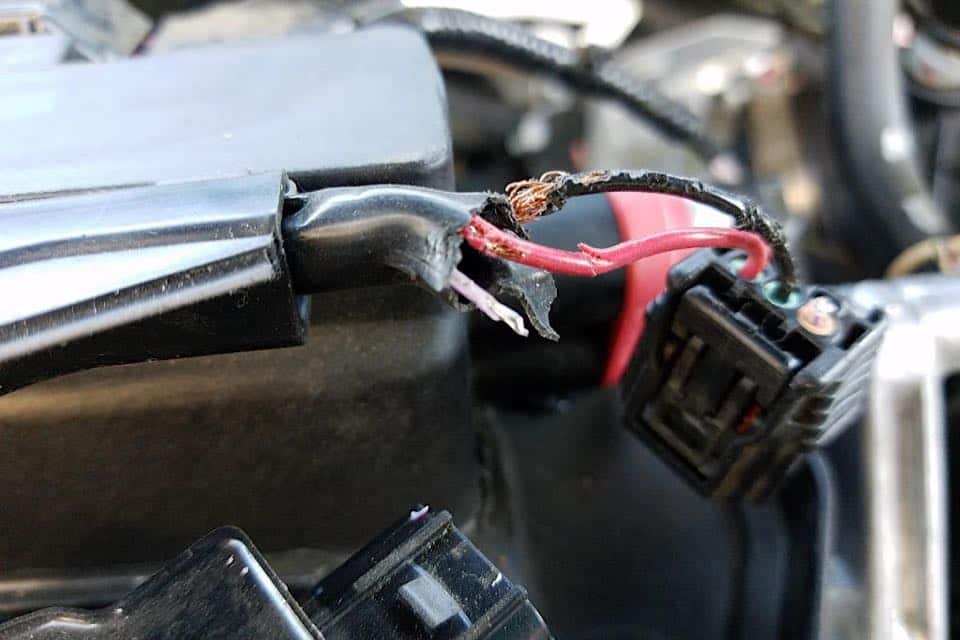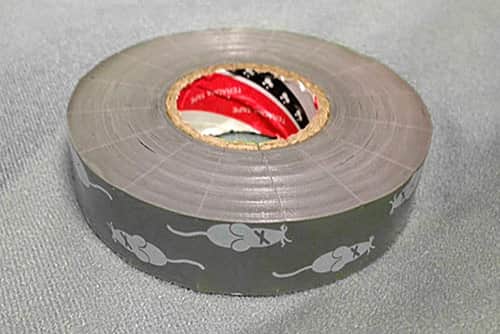Rodents Love Chewing Honda's Soy-Coated Wiring
- Honda uses a soy-based electrical wire coating that is cheaper and more environmentally friendly.
- It also tends to attract rodents that love the material for nest building.
- Prevention options are usually weird and range from coyote pee to capsaicin-laced tape.

You're meticulous about your Honda's maintenance --- you change the oil regularly, keep your tires rotated, and always make sure the fluids are topped off. But have you wrapped your wiring in spicy pepper tape? Yeah, you heard me.
The Consequences of "Going Green" ∞
Honda switched to a soy-based coating for their wiring that is more biodegradable. It sounds like a pro-Earth move by the automaker, but the real reason is probably a little less triumphant: the coating costs less than plastic. Still, less plastic in the landfill is always a good thing.
But like most good things, they come with consequences.
In this case, that consequence is passed on to the consumer who suddenly finds themselves with an engine full of rodent-friendly chewing material. You see, the soy-coating seems to be attracting rabbits, mice, and other rodents to use as a chew-toy and nesting material.
To be fair, Honda isn't the only automaker to make this switch or to have this problem.
Rodent damage can be a costly and frustrating expense ∞
A Honda mechanic told CTWatchDog.com that he sees more than 100 vehicles per year with rodent damage to the electrical systems. The repair costs can start at $50, but quickly balloon to $1,000, or --- in the worst case he'd seen --- $3,000.
""The soy products now used to create the wire insulation concerns me a great deal. This weekend my wife was driving our car, a 2010 Honda Accord, and while on the road the car started to shake and stutter violently, and would not accelerate. After having our car towed to the dealership, there was evidence that a rodent of some type had chewed on the cables. --- 2010 Accord Owner"
There are a few things you can do to prevent rodent damage:
- Regularly open the hood and inspect your engine for signs of rodent activity (so, poop)
- When you move the car, look for any shredded pieces of wire coating or other material that looks like a nest that might have fallen out.
- Clean all food out of your car, including food sealed in bags. This is especially important for dog food and treats.
- Some have had success with putting mothballs, dryer sheets, or liquid peppermint in their engine compartments.
- Wrap your electrical wiring in something rodents can't stand.
Honda's spicy rodent tape ∞
Unlike other automakers, Honda does seem to acknowledge this issue and offer a solution in the form of electrical tape treated with capsaicin. That's the same stuff found in hot peppers that turns chili into five-alarm chili.

The tape is available for purchase through dealerships (part number 4019-2317) and costs about $36 for a 20-meter roll.
Honda Soy-Coated Wiring Lawsuit ∞
A lawsuit says the soy-coated, environmentally friendly electrical wiring that Honda has been using is irresistible to rabbits, mice, and other rodents.
Soy vey.
The lead plaintiff says his 2014 CrossTour's wiring had been used as a chew toy. When he brought his car in for service, the mechanic found a rabbit living in the engine compartment. Can you blame the little guy? Free rides, something to gnaw on, and a warm place to hang out isn't a bad deal.
When the mechanic said the repair would cost $765, however, the rabbit hopped out on his portion of the bill.
The lawsuit says:
- Honda refuses to pay for repairs because the wiring isn't a "safety defect", which is debatable.
- Honda knows about the issue, but still makes owners pay for the tape which can help prevent it.
Vehicles Named in the Lawsuit ∞
The lawsuit paints a wide swath over the 2012-2015 model years. So that means the Accord, Accord Hybrid, Accord Plug-in Hybrid, Civic, Civic Hybrid, CR-V, CR-Z, Crosstour, Fit, Fit EV, HR-V, Insight, Jazz, Odyssey, Pilot, and Ridgeline.
"The 2015 Honda vehicles have a "green" product that consist of fuel lines and various wiring that has a soy based composition. Rodents are eating the fuel lines and wiring because of the soy based ingredient. I know of numerous vehicles that have leaked gasoline due to the damage caused by rodents." --- 2015 Honda Accord owner
Generations Where This Problem Has Been Reported
This problem has popped up in the following Honda generations.
Most years within a generation share the same parts and manufacturing process. You can also expect them to share the same problems. So while it may not be a problem in every year yet, it's worth looking out for.
10th Generation Accord
- Years
- 2018–2020
- Reliability
- 40th out of 58
- PainRank™
- 17.2
- Complaints
- 201
9th Generation Accord
- Years
- 2013–2017
- Reliability
- 54th out of 58
- PainRank™
- 49.34
- Complaints
- 1341
9th Generation Accord Plug-in Hybrid
- Years
- 2014–2015
- Reliability
- 3rd out of 58
- PainRank™
- 0.42
- Complaints
- 1
10th Generation Civic
- Years
- 2016–2020
- Reliability
- 47th out of 58
- PainRank™
- 27.22
- Complaints
- 471
9th Generation Civic
- Years
- 2012–2015
- Reliability
- 50th out of 58
- PainRank™
- 33.22
- Complaints
- 443
3rd Generation Civic Hybrid
- Years
- 2012–2015
- Reliability
- 14th out of 58
- PainRank™
- 1.78
- Complaints
- 10
4th Generation CR-V
- Years
- 2012–2016
- Reliability
- 51st out of 58
- PainRank™
- 34.7
- Complaints
- 1238
5th Generation CR-V
- Years
- 2017–2020
- Reliability
- 43rd out of 58
- PainRank™
- 21.19
- Complaints
- 481
1st Generation CR-Z
- Years
- 2011–2016
- Reliability
- 10th out of 58
- PainRank™
- 1.06
- Complaints
- 15
1st Generation Crosstour
- Years
- 2012–2015
- Reliability
- 23rd out of 58
- PainRank™
- 5.95
- Complaints
- 55
3rd Generation Fit
- Years
- 2015–2019
- Reliability
- 38th out of 58
- PainRank™
- 12.68
- Complaints
- 171
3rd Generation Insight
- Years
- 2019–2020
- Reliability
- 9th out of 58
- PainRank™
- 0.64
- Complaints
- 3
4th Generation Odyssey
- Years
- 2011–2017
- Reliability
- 41st out of 58
- PainRank™
- 18.06
- Complaints
- 478
5th Generation Odyssey
- Years
- 2018–2020
- Reliability
- 34th out of 58
- PainRank™
- 8.88
- Complaints
- 48
2nd Generation Pilot
- Years
- 2009–2015
- Reliability
- 44th out of 58
- PainRank™
- 21.64
- Complaints
- 548
3rd Generation Pilot
- Years
- 2016–2020
- Reliability
- 39th out of 58
- PainRank™
- 13.3
- Complaints
- 207
2nd Generation Ridgeline
- Years
- 2017–2020
- Reliability
- 27th out of 58
- PainRank™
- 7.64
- Complaints
- 59
Further Reading
A timeline of stories related to this problem. We try to boil these stories down to the most important bits so you can quickly see where things stand. Interested in getting these stories in an email? Signup for free email alerts for your vehicle over at CarComplaints.com.
Well, that didn't take long. An Illinois-based soy wiring lawsuit filed a few months ago has been dismissed.
While the case tried to assert that Honda's "rodent tape" was an admission of a problem with their soy-based wire coating attracting rodents, the judge saw it as an act of good customer service.…
keep reading article "The Illinois-Based Soy Wiring Lawsuit Has Already Been Dismissed"When Michael Preston's 2015 Accord lost its power steering, he was concerned. When he found out it was because mice had chewed through his car's wires, he was pissed.
His lawsuit, Michael Preston, et al., v. American Honda Motor Company, Inc. wants Honda to cover the problem for all 2013-2017 Honda owners and lessees in Illinois.…
keep reading article "Another Lawsuit Says Honda’s Soy Wire Insulation is Too Attractive to Rodents"A lawsuit says the soy-coated, environmentally friendly electrical wiring used by Honda in 2012-2015 vehicles is irresistible to rabbits, mice, and other rodents.
Soy vey. When the lead plaintiff brought his 2014 Crosstour in for service, the mechanic found a rabbit living in the engine compartment and using the wires as a chew toy. To be fair, it is a warm place to hang out with lots of free soy-based snacks.
Of course, it wasn't really free. The damage cost the owner $765 dollars. That's a lot of carrots.
We've certainly heard about this before. Honda defends itself by saying it sells anti-critter tape that can be wrapped around the wires. The tape is laced with enough capsaicin (the stuff that makes peppers hot) to melt the whiskers off anything that comes sniffing around.
The lawsuit thinks owners shouldn't get stuck paying for repairs and the red-hot-chili-tape should be available for free. What do you think?
keep reading article "Rodents Just Love Honda's Soy Wiring"